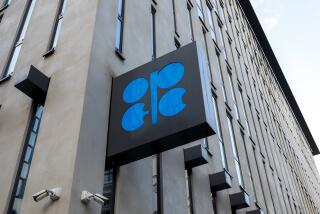Saudis Plan to Increase Oil Output Capacity
- Share via
Saudi Arabia, the world’s largest oil exporter, plans to expand output capacity by 14% to avert shortages as demand rises, the nation’s oil minister said Monday.
Saudi Arabia’s capacity will rise to 12.5 million barrels a day from 11 million now, said the minister, Ali Ibrahim Naimi, without giving a timetable.
“The spare capacity helps assure the continuity of stable markets by making more oil available in times of supply dislocations or any unusual surge in demand,” Naimi said in London at a Middle East conference organized by the Royal Institute of International Affairs.
He also said OPEC had no plan to stop using the U.S. dollar as the basis for oil sales, and he declined to reiterate support for the group’s official price target of $25 a barrel. Investors typically need higher prices for new projects, he said.
The Organization of the Petroleum Exporting Countries is pumping the most oil in 25 years in response to record demand growth and prices, which peaked at $55.67 a barrel in New York on Oct. 25 on concern about shortages and supply disruptions in Iraq, Nigeria and Russia. Oil has dropped 11% since then, closing Monday at $49.76, up 32 cents.
OPEC raised its production quota to 27 million barrels a day Nov. 1, the highest level on record for the 10 members that have self-imposed limits. The Vienna-based group plans to meet Dec. 10 in Cairo to discuss output targets. Saudi Arabia is now producing close to 9.5 million barrels a day, Naimi said.
Without a larger slide in prices, OPEC probably will do nothing to quotas when it next meets, said Adam Sieminski, oil strategist for Deutsche Bank.
“With things seeming to be stable, the best bet going into this meeting is they won’t do anything,” he said in London.
In response to questions, Naimi declined at least twice to specify the price of crude he wanted to achieve. “It is that price which consumers, investors and producers are happy with,” he said.
OPEC and its members are producing almost as much as they can, trying to catch up with demand, Naimi said. Increasing oil use is the primary factor in rising oil prices, he said. “The fear factor,” or concern that shortages will develop, probably adds $10 to $15 a barrel to prices, he said.
When asked about a weakening dollar, Naimi said OPEC would maintain its sales in the U.S. currency.
“OPEC has looked and looked, and every strategic team comes back with a statement that there is no merit in a change,” Naimi said.
More to Read
Sign up for Essential California
The most important California stories and recommendations in your inbox every morning.
You may occasionally receive promotional content from the Los Angeles Times.










